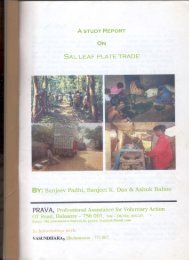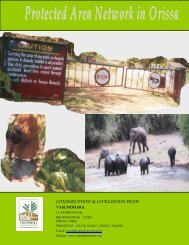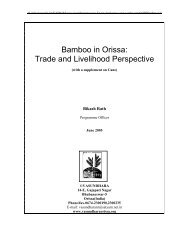DEVOLUTION OF FOREST MANAGEMENT - Vasundhara
DEVOLUTION OF FOREST MANAGEMENT - Vasundhara
DEVOLUTION OF FOREST MANAGEMENT - Vasundhara
- No tags were found...
Create successful ePaper yourself
Turn your PDF publications into a flip-book with our unique Google optimized e-Paper software.
11According to the villagers, no serious conflicts/ physical clashes took place with anyoutsiders over the sharing of benefits from the forest. However, they had amisunderstanding with their neighbouring village Chettenpalli after the protection wasstarted. Protection of a large area by Suruguda people affected the Chettenpalli village,which was left with no forest area adjoining their village for protection. They toostarted protecting a portion from the same patch. Perceiving threat of future conflicts,Suruguda village took steps for resolving the problem.According to the then President Shri Dukalu Prushet of Suruguda forest protectioncommittee was aware of the fact that the villagers legally have no rights over reserveforest. So they felt that if they denied a sharing from the resource to Chettenpallivillage, and the case goes to the FD, then they might lose the entire area. With thisapprehension people of Suruguda contacted the DFO for allocation of areas and hehelped the villagers in demarcating the boundaries between the two villages.Chettenpalli village was given 56 acres from the patch being protected by Surugudaand Suruguda retained 200 acres of forest areas. Boundary demarcation was done inthe presence of the Range officer, Forester and Forest guard.At the initial stage the community institution was in the form of an informalcommittee. During that time there was dominance of the so-called “lower” castes. Thisalso happened, as they had a greater hand in the initiation process.The changes in the community institution came when it was formalised first as VFPCin 1989 and later as VSS in 1994.Leadership in the community institution has had an important role to play in itsfunctioning and resilience. The initial President of the forest protection groupprovided leadership for about 7-8 years. He was popular in the village and enjoyed thetrust of majority of the villagers and effectively managed the community institution.People consider his tenure as the most stable period of the forest protectioncommittee. After his stepping down, there have been quick changes in the committee.A possible explanation for this is the attitudinal change. It is visualised by the peoplethat the new generation leaders considers the VSS committee is a source of power andposition. They don’t show much interest in forest management.Although the FD intervened way back in 1989 it only in the year 1994 that thecommittee got a more formal shape with the formation of VSS. Thus there has been agradual transformation of the institution i.e. from an informal institution to a formal setup. With this change in the structure of the organisation the status and style offunctioning of the institution also underwent a change.3.4 GENDER AND EQUITY CONCERNSAlthough the VSS is considered to be an important institution by the villagers, itsworking is confined to the protection process only and it has no role in the other affairsof the village. Though there has been a fair representation of every community in thecommittee, women do not play a significant role in the actual functioning of theinstitution.Women were included in the Forest Protection Committee only after the formation ofthe VSS, in consonance with the JFM norms, which stipulates a minimum
















